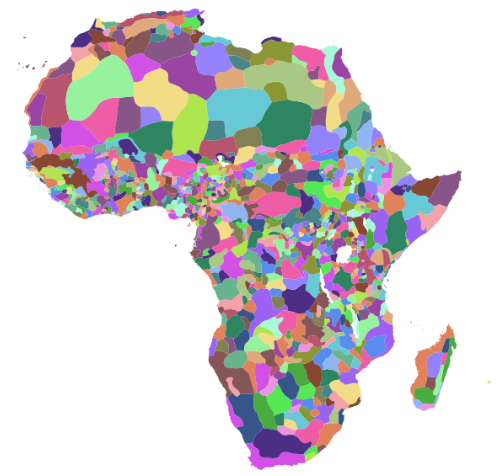6.2: Pre-Colonial Sub-Saharan Africa
- Page ID
- 21082
Africa has a long history of human habitation giving rise to numerous cultural and linguistic groups. Early humans were primarily gatherers, and there is evidence of people gathering nuts, grasses, and tubers around 16,000 BCE in the highlands of Northern Ethiopia. Around 10,000 years ago, the domestication of the first crops and livestock developed in Africa and the practice of settled agriculture began.
In pre-colonial Africa, women were, and still are in many areas, the primary agriculturalists. It was the responsibility of women to understand the seasonality of crops and this, along with the role of bearing and rearing children, gave women an important role in African society. Many early religions placed a strong emphasis on female goddesses reflecting the central role of women in society. Men were primarily the hunters and gatherers.
For early Africans, the family was the basic and most important social unit. It was the family unit that owned and accessed land rather than individuals. Furthermore, land could not be bought or sold, but instead was passed down through the tradition of partible inheritance, meaning land is divided among the heirs. Elsewhere in the world, such as in the United Kingdom for much of its history, land was passed down to the firstborn male, known as primogeniture. With partible inheritance, however, no landed aristocracy developed since every male was given an equal share rather than just the firstborn.
If the family was the basic social unit in African society, it was the extended family that was the most important politically. Tribes, consisting of groups of families united by a common ancestry and language, controlled distinct tracts of territory. In pre-colonial Africa, there were over 800 distinct ethnic regions – and some of the ethnic regions identified by anthropologists actually had multiple distinct cultural groups within them (Figure \(\PageIndex{1}\)). Tribal groups sometimes coexisted peacefully, and other times, warred over territory.

Pre-colonial Africa was also the site of a number of large empires (Figure \(\PageIndex{2}\)). The Kingdom of Kush, for example, was established in 1070 BCE and located on the Nile River just south of the Egyptian Empire. The Kingdom of Aksum located in present-day Eritrea and Ethiopia existed from 100 CE to 940 CE and was one of the most powerful of the pre-colonial African empires. The rulers of the kingdom minted their own currency, built religious monuments, and established trading routes. The first state in West Africa was the Empire of Ghana, which lasted from around 350 CE until its conquest by the Mali Empire in the 1200s CE. The Empire of Ghana had a large capital city, markets, and a system of taxation.

Two historical events brought significant change to Africa’s cultural landscape and history. The first was the spread of the Islamic Empire across North Africa beginning in the 7th century CE. The second was the start of the transatlantic slave trade in the 15th century CE. Slavery was present in Africa long before European conquest, however. In some pre-colonial African societies, as in other parts of the world, slavery was a part of the local community. Slaves might be taken from conquered groups or given as gifts. In general, though, slavery represented a relatively small segment of ancient African society and economy.
European contact with Africa was initially focused on establishing a port along the West African coast, a place to resupply along the long trip to South and Southeast Asia. Beginning in the 15th century, however, this objective shifted to gaining resources. Portugal was the first of the Europeans to begin buying enslaved Africans. The Portuguese, originally interested in trading for gold and spices, set up several sugar plantations on the islands of São Tomé, off the western coast of Equatorial Africa. Portugal then brought in slaves to help cultivate the sugar. The Spanish then began buying slaves to send to the New World in the early 16th century, bringing them first to the islands of Cuba and Hispaniola. Initially, Europeans raided coastal African villages in order to secure slaves, but over time, began purchasing slaves from African rulers and traders.
Since pre-colonial Africa was divided into distinct ethnolinguistic regions, Africans generally saw themselves as part of their ethnic group or tribe rather than as united by a “black” or “African” identity. Thus, the slaves sold by Africans were seen as “other,” something different or less than themselves. Europeans developed military alliances and beneficial trading partnerships with some of these groups to ensure a steady supply of slaves. By 1700 CE, around 50,000 slaves were being shipped out of Africa each year, and though it is difficult to know the exact total number of people sold into slavery, it is estimated that around 12 million Africans were shipped to the New World.
During this time, many African groups practiced a form of agriculture known as shifting cultivation, where one area of land is farmed for a period of time and then abandoned until its fertility naturally restores. Eventually, farmers return to the abandoned plot of land after many years, which is now overgrown, and often burn the vegetation, known as slash-and-burn, in order to return the nutrients to the soil. Because of this, much of the land in Africa looked unused, but was actually part of a larger agricultural system. Colonial empires took over these fragments of unused land to set up their own agricultural systems.
For some time, European empires had this relatively piecemeal approach to Africa, taking resources, land, and slaves without directly controlling territory. Europeans had little interest in the interior of Africa and were primarily focused on the coastal areas. This would completely change beginning in the late 19th century as European powers scrambled for control of the continent.
- Tribes:
-
a group of families united by a common ancestry and language
- Shifting cultivation:
-
a system of agriculture where one area of land is farmed for a period of time and then abandoned until its fertility naturally restores


